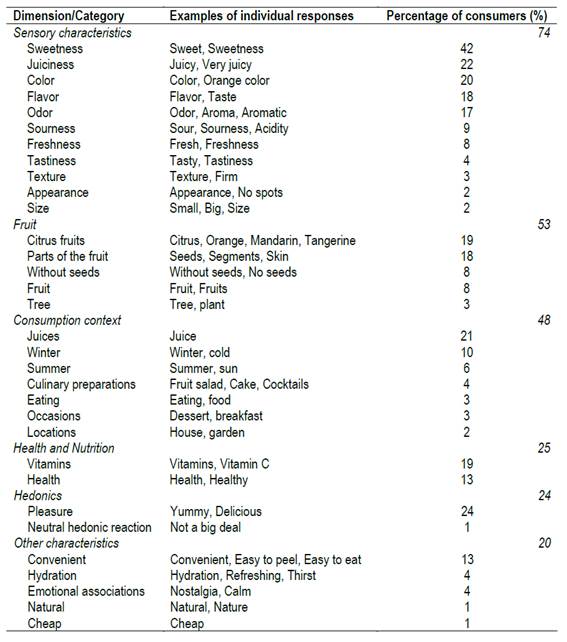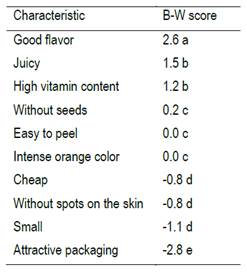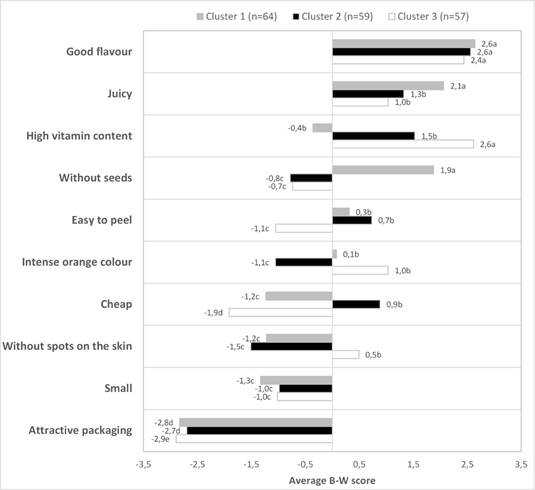1. Introduction
During the last decade, mandarin production has increased by 30% worldwide, creating new market opportunities1. Consumers have been identified as a major driving force of this situation due to the exponential increase in the demand for new varieties that fulfill consumers' sensory and hedonic expectations1. However, breeding strategies have been traditionally focused on improving on-tree productivity, fruit appearance, adaptation to local conditions and resistance to pests and diseases2. In order to develop mandarin cultivars that meet consumers expectations, the sensory characteristics of mandarins are increasingly considered as part of breeding programs1)(3)(4)(5)(6 as well as to the development of strategies to increase mandarin consumption in the different markets.
Sensory characteristics are key determinants of consumers' purchase and consumption decisions of mandarins. Different studies conducted in the United States of America (USA) and Spain have reported that sweetness, acidity and mandarin flavor are the most important factors driving consumers' willingness to try a mandarin4)(7)(8. In addition, previous studies with consumers reported that juiciness, skin quality, sweetness and texture were the most important characteristics for citrus fruits9. However, consumers' perception of mandarins is expected to depend likewise on non-sensory characteristics. In this sense, convenience of consumption, easy peeling and easy carrying have been identified as relevant characteristics for mandarin consumers1)(7)(8. In this sense, mandarins content a wide range of antioxidants and vitamins that could contribute to the prevention of non-communicable diseases, and could also be relevant for consumers with a strong health-motivation1)(10)(11)(12.
Consumers’ preferences, purchase and consumption of mandarins depend on the complex interaction between their individual characteristics (i.e. gender, age, habits, psychological traits), fruit sensory and extrinsic characteristics (i.e. price, packaging), as well as the context where decisions are made13. Currently, there is no information available on the factors influencing consumers' purchase of mandarins in Latin America. This information is crucial for breeding programs, and for the development of communication and marketing strategies aimed at increasing fruit sales and consumption.
In this context, the aims of the present work were: i) to explore Uruguayan consumers' perception of mandarins, and ii) to identify the key characteristics that drive mandarin purchase decisions.
2. Materials and methods
2.1. Participants
A total of 197 people (58% female, ranging in age between 18 and 86 years old -mean=46.4, SD=15.4) participated in the study. They were recruited at a local supermarket in the metropolitan area of Montevideo (Uruguay) while doing their purchases at the fruit and vegetable section. Consumers were intercepted by one of the researchers involved in data collection, who asked them if they consumed mandarins. Consumers who answered affirmatively were asked to take part in the study. All participants signed a consent form and received a small gift for their participation.
2.2. Questionnaire
The study was conducted in the supermarket where participants were recruited. Researchers read the questions aloud and registered the participants' responses in a paper ballot.
The first part of the questionnaire involved a word association task14. Participants were asked to say all the words that came to their mind when thinking of mandarins. They were encouraged to say as many words as possible.
After the word association task, participants were asked to complete a best-worst scaling task15 aimed at capturing the relative importance of a series of factors when purchasing mandarins. They were presented with 10 choice sets composed of 5 characteristics of mandarins. For each of the choice sets, participants were asked to indicate the most and least important when purchasing for mandarins. The choice sets were created using a balanced incomplete block design based on the following 10 characteristics: “Without seeds”, “Easy to peel”, “Intense orange color”, “Good taste”, “Small”, “Without spots on the skin”, “High vitamin content”, “Juicy”, “Cheap”, and “Attractive packaging”. The choice sets were presented to participants following a Williams' Latin square design to minimize order and carry over effects. The presentation order of the characteristics within each of the 10 sets was also balanced using a similar procedure.
Finally, participants answered a series of socio-demographic questions (gender, age, education level, place of residence, number of children in the household) and stated their consumption and purchase frequency of mandarins.
2.3. Data analysis
Data from the word association task were analyzed using content analysis based on inductive coding16. Responses with similar meaning were grouped into categories as they emerged from the data. Two of the researchers who authored the study (with a minimum of two years of experience in consumer content analysis) performed an initial coding of the data. After completing an individual coding, the two researchers held a meeting to define the final categories by consensus. Results presented in the current paper represent the consensus between the two researchers. The same procedure was used to group the categories into dimensions. The percentage of consumers who provided responses within each category and dimension was calculated.
Data from the best-worst scaling were analyzed following the procedures recommended by Louviere and others15. For each consumer, the number of times that each characteristic was selected as most and least important was counted across the 10 choice sets. These two values were then subtracted to calculate B-W scores for each characteristic. Analysis of variance (ANOVA) was used to compare the B-W scores of the 10 characteristics. A confidence level of 95% was considered. Tukey's test was used for post-hoc comparison of average values.
Hierarchical cluster analysis was performed on the B-W scores to identify groups of consumers who attached different importance to the 10 characteristics when purchasing mandarins. Euclidean distances and Ward's agglomeration criterion were considered. The identified groups were compared in terms of their socio-demographic characteristics using the chi-square test.
3. Results
3.1. Consumers' associations with mandarins
A total of 179 different words and expressions were mentioned when participants were asked to say the first words that came to their mind when they thought of mandarins. Following an inductive coding approach, responses were grouped into 33 categories, which were subsequently merged into six dimensions. The percentage of participants who provided responses related to each category and dimension are shown in Table 1, along with examples of responses.
Table 1: Percentage of consumers who provided responses within each of the dimensions and categories identified in the content analysis based on inductive coding performed on responses to the word association task about mandarins, and examples of individual responses

The dimension Sensory characteristics was the most frequently mentioned when participants thought of mandarins. All the responses related to this dimension were connected to typical sensory characteristics of the product. As shown in Table 1, the most relevant category within this dimension was Sweetness, followed by Juiciness, Color, Flavor and Odor. The remaining responses related to sensory characteristics were mentioned by less than 10% of the participants.
The second most frequently mentioned dimension was Fruit, which included responses related to citrus fruits, parts of the fruit (e.g. seeds, segments, skin), general associations with fruits, trees and plants (Table 1). The third most salient dimension was related to product consumption, which was mainly associated to consumption occasions (e.g. winter, occasions and locations) or ways to consume mandarins (i.e. juices, culinary preparations).
Responses within the remaining dimensions were mentioned by 25% of the participants, or less. As shown in Table 1, mandarins raised associations with health and nutrition, particularly vitamins and health, as well as with hedonic aspects of product consumption. In particular, it is worth highlighting that 24% of the participants associated mandarins with pleasure by mentioning words such as Yummy or Delicious. Another relevant association was related to convenience, as 13% of the participants referred to convenience, ease of peeling and ease of eating (Table 1).
3.2. Relative importance of mandarins' characteristics for consumers' purchase decisions
Best-worst scaling was used to evaluate the relative importance of 10 characteristics of mandarins for consumers’ purchase decisions. ANOVA of the B-W scores revealed significant differences between characteristics (F9,1790=160.8, p<0.001), indicating that they differed in the relative importance that consumers attached to them when making their purchase decision. As shown in Table 2, good flavor was the most important characteristic underlying consumers' purchase decisions of mandarins, followed by juiciness and high vitamin content. On the contrary, attractive packaging was the least important characteristic.
Table 2: Results from the best-worst scaling showing the relative importance of 10 characteristics of mandarins, expressed as average B-W scores among participants

Note: B-W scores for each participant and characteristic were calculated by subtracting the number of times that the characteristic was selected as most important (B) across the 10 choice sets and the number of times it was selected as least important (W). B-W scores with different letters are significantly different according to Tukey's test for a 95% confidence level.
Three groups of consumers who attached different relative importance to the evaluated characteristics of mandarins were identified using hierarchical cluster analysis. No significant differences were found in the distribution of the clusters according to their socio-demographic characteristics or consumption frequency of mandarins (all p-values higher than 0.092).
As shown in Figure 1, flavor and juiciness were among the most important characteristics for the three clusters, whereas small size and attractive packaging were among the least important. However, the clusters largely differed in the relative importance attached to six characteristics: high vitamin content, without seeds, easy to peel, intense orange color, cheap and without spots on the skin. Consumers in Cluster 1 (n=64) were characterized by the high relative importance attached to the attribute “without seeds”. Meanwhile, Cluster 2 gave higher relative importance to “ease of peeling” and “cheapness” and lower importance to “orange color”. Finally, Cluster 3 (n=57) tended to attach higher importance to “vitamin content” and “absence of spots on the skin”, and lower importance to “ease of peeling” compared to the other two clusters. These consumers also gave higher relative importance to “juiciness” compared to the other two groups of consumers.
4. Discussion
The present study explored Uruguayan consumers' perception of mandarins using a mixed approach that involved word association and B-W scaling. Results from the word association task showed that mandarins raised a wide range of associations related to their sensory characteristics, consumption context, health, nutrition and hedonic characteristics. Responses related to sweetness were the most frequently mentioned, suggesting that this sensory characteristic is the most relevant for consumers' conceptualization and the most influential on their purchase decisions14. Previous studies conducted in USA have reported that sweetness and flavor are key drivers of consumers' willingness to purchase mandarins7)(8)(17. Additionally, juiciness and color were also relevant sensory characteristics for consumers' conceptualization of mandarins.
Results from the B-W scaling highlighted the importance of sensory characteristic good flavor as the most important characteristic underlying consumers' purchase decisions of mandarins. According to Kurzer and others17, adults feel frustrated by the lack of flavor and inconsistent sensory quality of mandarins. These results stress the need to integrate sensory and consumer science into breeding programs in order to improve marketability of new cultivars and increase consumption of mandarins4)(18. Integration of sensory information through the use of novel and rapid methods has proven to be successful in the breeding programs of other crops19)(20)(21. Sensory studies will also provide crucial information to fulfill consumers satisfaction through different steps of the citrus commercialization chain. Since fruit flavor and juiciness can be affected by storage time and conditions (1,74), sensory studies would provide crucial information during citrus conservation experiments.
The importance of flavor for consumers' conceptualization and purchase decisions of mandarins suggests that strategies to increase consumption of this product should focus on sensory and hedonic aspects rather than health-related ones. Given the importance of pleasure on consumers' food choices, this approach has been recommended by Pettigrew22 for promoting healthier eating habits.
From a marketing perspective, the results point towards opportunities for the differentiation of cultivars in the marketplace. New cultivars could be differentiated at the point of purchase based on key sensory attributes, such as sweetness, juiciness and mandarin flavor. In this sense, tastings at supermarkets and markets could contribute to familiarizing consumers with the characteristics of new cultivars and increase their purchase intention. Consumers may be willing to pay more for premium cultivars with distinct and consistent sensory quality, as reported by Kurzer and others, and it will be important to provide positive experiences to stimulate consumption8.
Health related-aspects, and particularly vitamin C content, were identified as a relevant component of consumers' conceptualization of mandarins, suggesting that they are aware of the nutraceutical benefits of this products. High vitamin content showed high relative importance in the B-W scaling, which can be attributed to the fact that consumers clearly associate vitamins with a healthy diet23. However, it is worth noting that sensory characteristics were more important than vitamin C content for consumers' purchase decision of mandarins, suggesting that they may not be willing to compromise pleasure for potential health benefits. For this reason, marketing of cultivars based merely on claims related to vitamin C may not be successful. In this sense, a previous study conducted in USA showed that although consumers were positive about vitamin C labelling, information about this nutrient did not increase their willingness to purchase24. Another study showed that younger consumers are more aware of healthiness, easy of peeling, social use and eating preferences when choosing citrus17.
Although consumers agreed in the high relative importance attached to sensory characteristics, heterogeneity in the relative importance attached to other characteristics was identified, coinciding with previous works24. This suggests the existence of marketing segmentation. In the present work, consumer segments providing different relative importance to the evaluated characteristics of mandarins did not significantly differ in their socio-demographic characteristics. This result is in agreement with the fact that behavioral variables have been claimed to have more explicative power on consumers' food purchase decisions than demographics25. Further research is needed to identify the psychographic and behavioral determinants of differences in the relative importance attached to different characteristics of mandarins.
The identified groups of consumers differed in the relative importance attached to ease of peeling and lack of seeds, two characteristics that have been previously identified as important drivers of consumers’ purchase intention of mandarins17)(24. The present study suggests that easy to peel mandarins without seeds may be particularly appealing for a market niche. Marketing of mandarin cultivars based on their sensory characteristics can help consumers to identify and select products that meet their expectations, which could potentially contribute to increase consumption.
5. Conclusions
Sensory aspects (juiciness, sweetness, color, flavor and odor) were the most salient concepts associated with a mandarin, followed by fruit characteristics and consumption context. Mandarin flavor was the most important characteristic underlying consumers' purchase decisions, followed by juiciness and high vitamin content; while packaging, size or price resulted less relevant. This stresses the importance of including sensory analysis as an integral part of breeding programs and conservation experiments.
















